30 percent of all products ordered online are eventually returned. Unfortunately, returns are a part of eCommerce life.
eCommerce returns aren’t all bad news though. With the right refund and return policy, you can boost customer loyalty, attract more sales and minimize negative reviews.
Read on to discover the benefits of a well crafted returns policy and what to include in yours. We’ve added some real examples of eCommerce return policies from some of the world’s top online retailers, to show you how it’s done!
Why you need an eCommerce return policy
It’s understandable why some eCommerce retailers shy away from displaying a clear returns policy at first. No one likes to lose a sale. However, a good eCommerce return policy offers significant benefits for online sellers.
Firstly, they motivate online shopping. After return shipping, the top driver of online shopping is the ability to make free returns and exchanges, according to a 2018 survey:
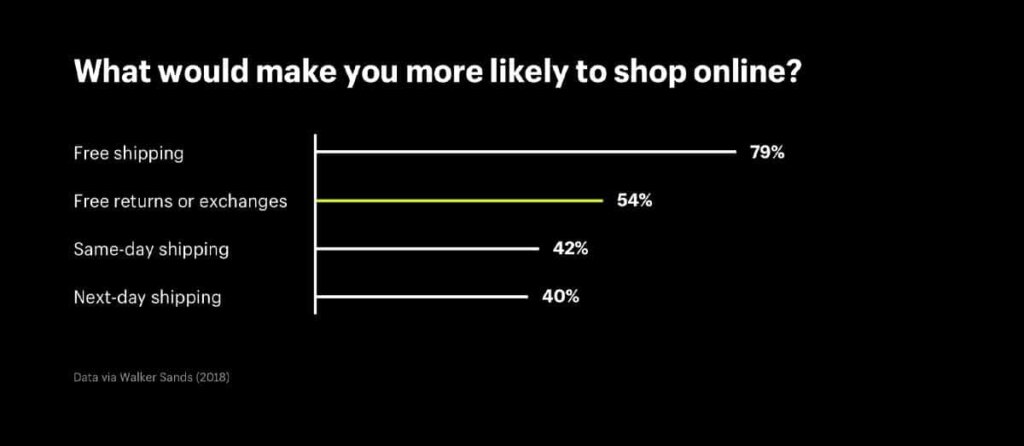
Moreover, customers expect a flexible eCommerce return policy. 49% of online shoppers check the returns page before making their purchase. Half of shoppers will avoid shopping altogether from eCommerce sites that don’t offer returns.
Not only do customers expect them, but a good eCommerce return policy can be a major selling point for your brand. This is why we’ve seen an emergence of D2C brands using their free returns as part of their core brand messaging:
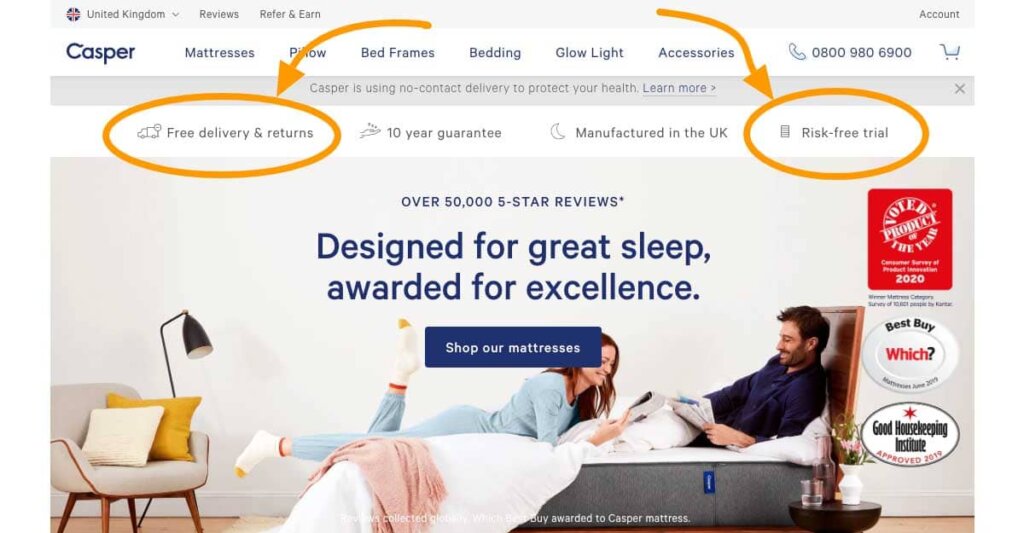
A good eCommerce returns policy also boosts customer loyalty. 96% of shoppers say a “good returns experience” makes them want to shop with a retailer again.
Best of all, allowing refunds on your eCommerce site can increase overall revenue. One study calculated a revenue lift as high as 47%.
What to include in your eCommerce return policy, with examples
Having a clear, well-written eCommerce returns policy is just good business sense. Here’s what to include in yours.
1. Explain what types of returns or exchanges you offer
First, determine whether your return policy will offer full refunds, partial refunds, exchanges, or store credit—or a mix of the above. You may also choose to list some items as “final sale.”
On your refund page, outline which options are available for which products. The lengthy Amazon return policy outlines specific conditions for all of their product categories:
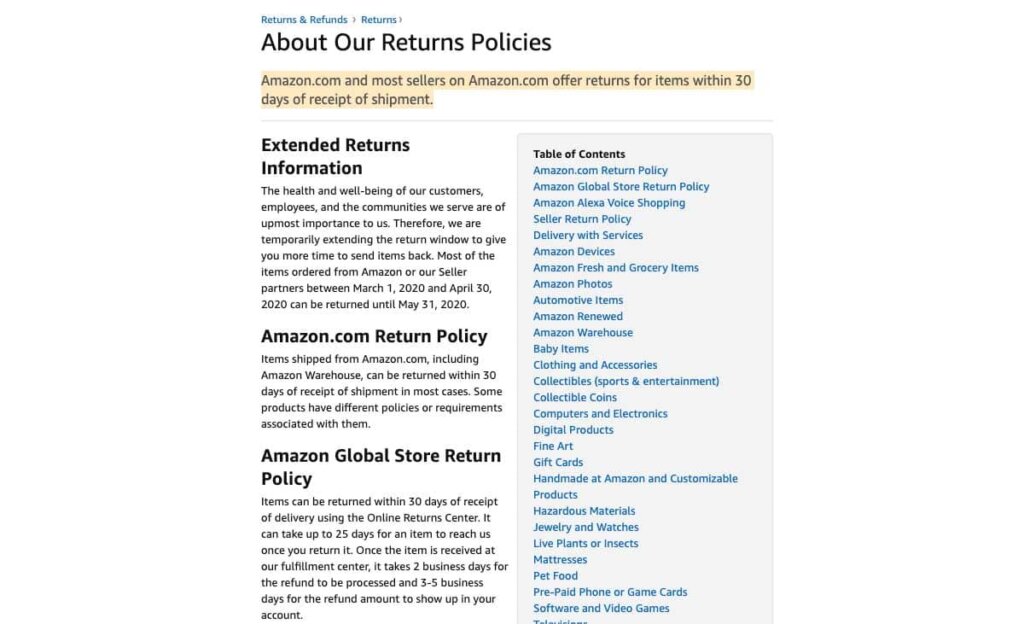
Amazon has a dedicated returns policy for their “Fulfilled by Amazon” products. One of the key benefits of using FBA is being able to use Amazon’s customer service network. This includes product returns.
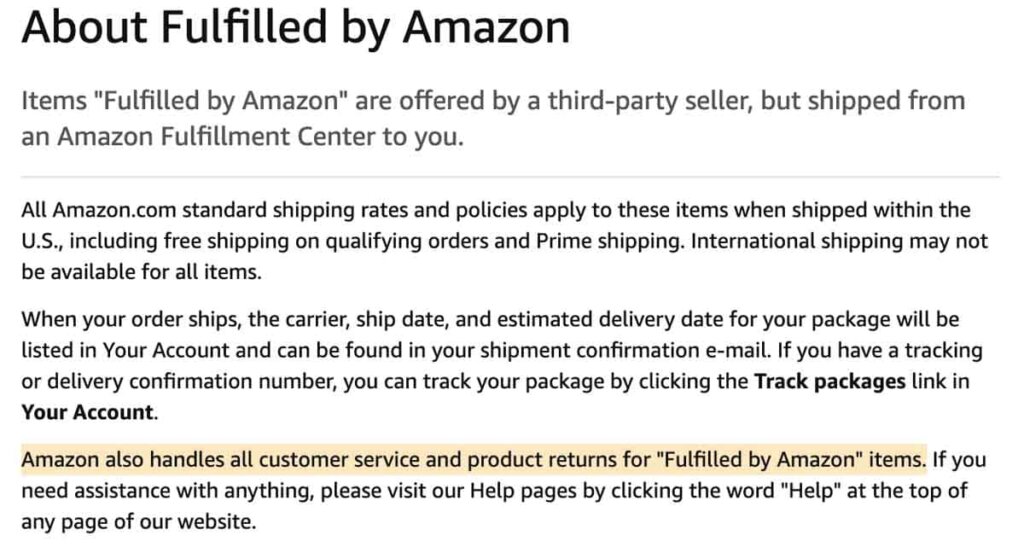
2. Describe the condition required for all returned products
Next, tell customers what state the product must be in to qualify for a refund or exchange. Can the product be opened, or must it be completely unused and unopened? Must any tags or protective packaging be intact?
If you have a brick-and-mortar location, share your policies for returns purchased in-store. Can customers return items they purchased online in-store, and vice versa?
Here’s an example of an eCommerce returns policy from Marks and Spencer:
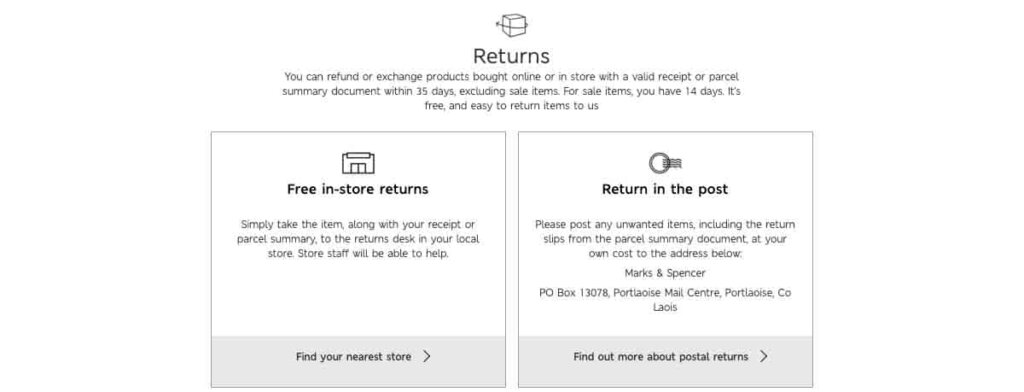
3. Determine the return and exchange period
The majority of customers expect a 30-day return policy, so that’s a good minimum to start with. This gives people sufficient time to figure out if they want to make a return, and if so, to go about doing it.
Be clear about when the 30 days begins and ends. Does it begin once the customer’s order is shipped, or once it arrives? If their package is postmarked within 30 days, will that suffice, or does your facility need to receive it within 30 days?
In their return policy, eBay includes a “ship by” date that advises shoppers of the last day they have to ship a returned item in order to meet the return deadline:

4. Be upfront about return shipping costs
If you can afford it, we recommend offering free return shipping. Over two-thirds of shoppers say having to pay for return shipping or restocking fees is reason enough for not buying from an eCommerce store.
eBay’s returns policy offers different conditions for who pays for return shipping, depending on the reason for the return:

5. Give step-by-step instructions for making a return
Clearly outline what the customer needs to do to process their return. In addition to meeting the deadlines and other criteria you’ve set, how should they package their return? Do they need to keep all original packaging, or can they use their own? What about the order slip?
If you’re paying for shipping, will you provide the shipping label on your website? Some eCommerce companies include this with the original package, to make it just one step easier. If the customer pays for shipping, give them your shipping address.
The Asos return policy is an example of how to do this right:
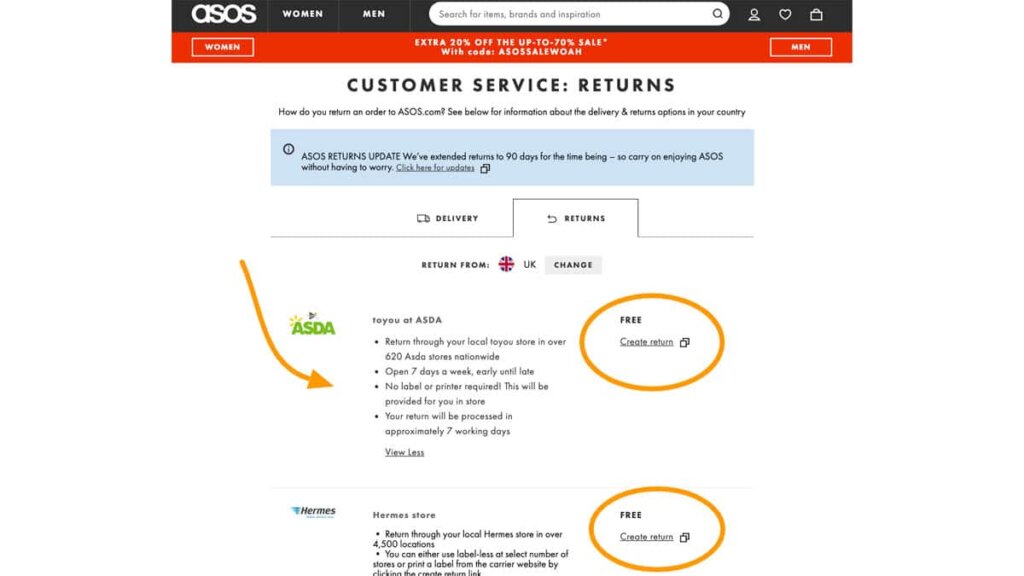
Their refund policy offers easy, step-by-step instructions for their customers to follow to prepare their return for shipping, including a button they can click to print their return label.
6. Tell the customer what happens after they send in their return
Part of having a good eCommerce returns policy is explaining what happens after the customer ships their item back. They don’t want to feel like they’re sending their returned items into the abyss. Describe how long it typically takes for you to process a return and issue the refund to their credit card.
In their return policy, True & Co stays true (no pun intended!) to their promise of “free and easy returns”:
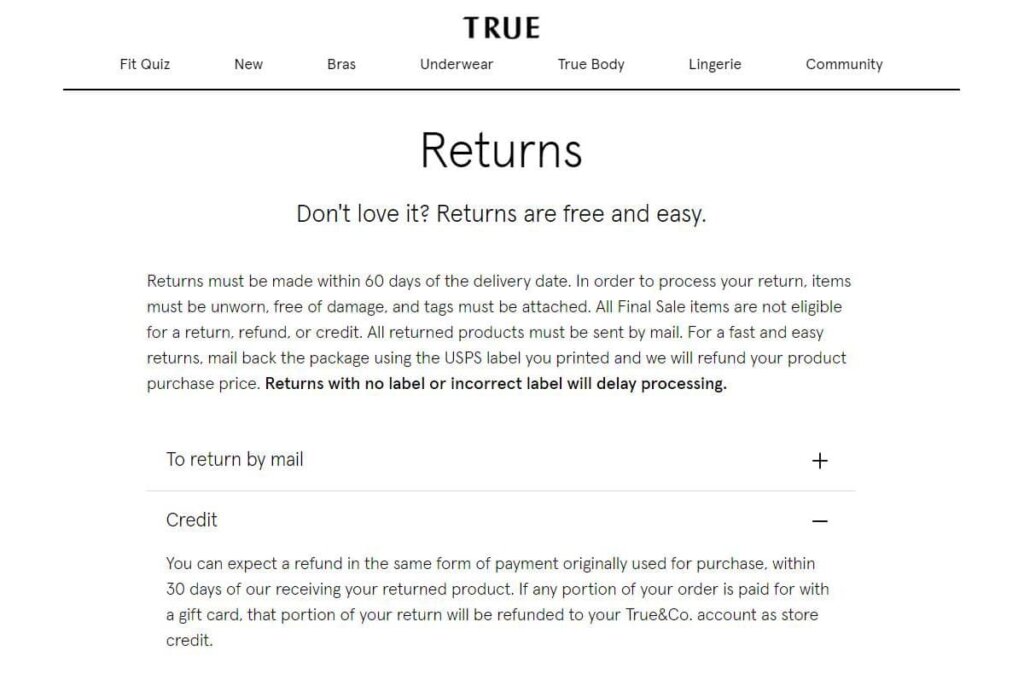
Their eCommerce returns policy is easy to read, with expandable FAQ and lots of white space. They explain steps the customer can take to expedite their return (like ensuring they use the appropriate label), and mention when and where the refunded payment will be applied.
7. Explain what happens if a return is denied
Sometimes, despite your crystal-clear return policy, customers will still send you a return that you can’t accept. Maybe it was clearly used or damaged on arrival, or it arrived well past the return date.
How can you handle this situation? Take a cue from Shopify’s returns policy:
While allowing returns can improve customer satisfaction, a rejected return can decrease it. Shopify stops potential customer complaints before they happen by giving them options: they can either keep their purchase (and pay a return shipping cost of $30), or let Shopify recycle it.
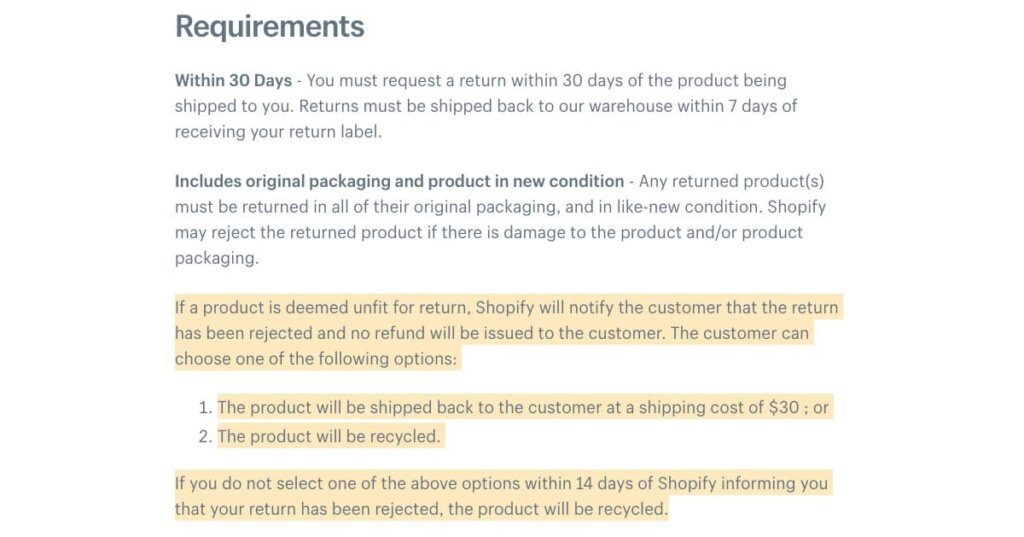
8. For large online stores, consider a FAQ page
For larger online stores, or stores with different return conditions for various product categories, it can be helpful to organize your returns policy like a FAQ section. This allows shoppers to browse and quickly find the answer they are looking for.
Take this example eCommerce returns policy from Boots:
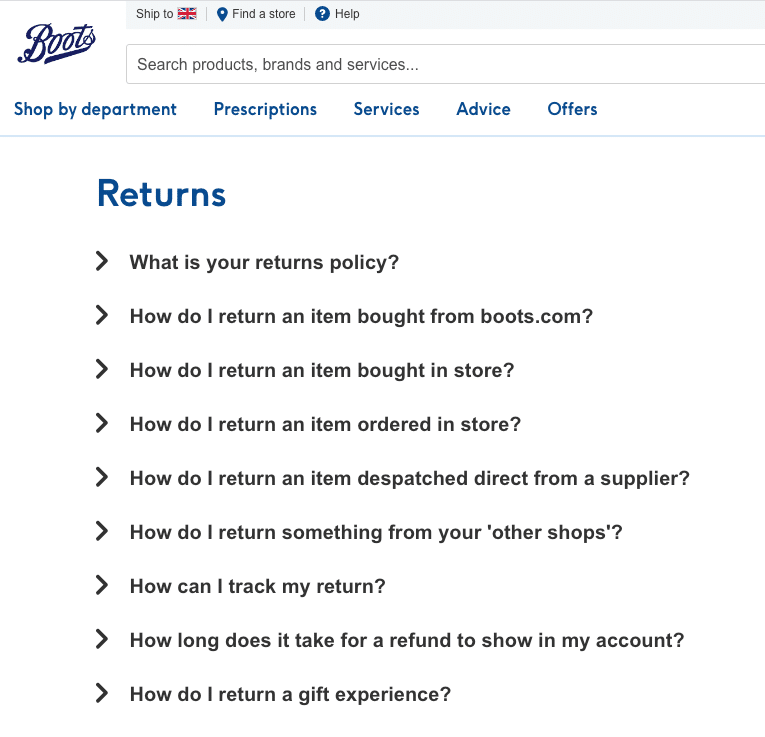
In their returns page, Boots has answered every question their shoppers may have about returning something. All of the questions are expandable, but they’re left un-expanded by default so customers can quickly glance to find the question they need.
9. Make it easy to find
Finally, help customers make their returns easily. In one study, one-third of shoppers chose not to buy from an e-retailer simply because their eCommerce returns policy was too difficult to find. Link to your return policy from your website footer, your customer service or FAQ pages, and your product pages.
For example, Waterstones links to their return policy from every page of their website:

10. Returns can be good for business
Like many aspects of marketing, a good eCommerce returns policy is all about setting expectations, and beating them. Be clear about what’s accepted in your returns policy, and what isn’t. Make it easy for customers to follow. Then, watch your customer satisfaction rates soar.


